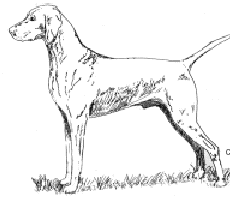Note: the text below is copied in full from DogsNZ website: https://www.dogsnz.org.nz/breeds/info/hungarian-vizsla/306 I have modified two items in the text (in red and struck-through) to reflect recent legislative changes in New Zealand.
A breed standard is the guideline which describes the ideal characteristics, temperament, and appearance of a breed and ensures that the breed is fit for function with soundness essential. Breeders and judges should at all times be mindful of features which could be detrimental in any way to the health, welfare or soundness of this breed.
Breed Standard - Hungarian Vizsla
 Characteristics: The Hungarian Vizsla should be lively and intelligent, obedient but sensitive, very affectionate and easily trained. It was bred for hunting for fur and feather on open ground or in thick cover, pointing and retrieving from both land and water.
Characteristics: The Hungarian Vizsla should be lively and intelligent, obedient but sensitive, very affectionate and easily trained. It was bred for hunting for fur and feather on open ground or in thick cover, pointing and retrieving from both land and water.
General Appearance: A medium sized dog of distinguished appearance, robust and not too heavily boned.
Head and Skull: The head should be gaunt and noble. The skull should be moderately wide between the ears with a median line down the forehead and a moderate stop. The muzzle should be a little longer than the skull and although tapering should be well squared at the end. The nostrils should be well developed, broad and wide. The jaws strong and powerful. The lips should cover the jaws completely and should be neither loose nor pendulous. The nose should be brown.
Eyes: Neither deep nor prominent, of medium size, being a shade darker in colour than the coat. The shape of the eyes should be slightly oval and the eyelids should fit tightly. A yellow or black eye is objectionable.
Ears: The ears should be moderately low set, proportionately long with a thin skin and hang down close to the cheeks, should be rounded V-shaped not fleshy.
Mouth: Sound white teeth meeting in a scissor bite, full dentition is desirable.
Forequarters: Shoulders should be well laid and muscular, elbow straight pointing neither in nor out, the forearm should be long.
Body: Back should be level, short, well muscled, withers high. The chest should be moderately broad and deep with prominent breast bone. The distance from the withers to the lowest part of the chest should be equal to the distance from the chest to the ground. The ribs should be well sprung and the belly should be tight with a slight tuck:up beneath the loin. The croup should be well muscled.
Hindquarters: Should be straight when viewed from the rear, the thighs should be well developed with moderate angulation, the hocks well let down.
Feet: Rounded with toes short, arched and well closed. A cat like foot is desirable, hare foot is objectionable. Nails short, strong and a shade darker in colour than coat, dew claws should be removed.
Gait: Graceful and elegant with a lively trot and ground covering gallop.
Tail: Should be of moderate thickness, rather low set, with one third customarily docked off. Whilst moving should be held horizontally.
Coat: Should be short and straight, dense and coarse and feel greasy to the touch.
Colour: Russet gold. Small white marks on chest and feet, though acceptable, are not desirable.
Weight and Size: Optimum Weight 22 - 30 kg (48.5-66 lb) .
Height at withers Dogs: 57-64 cm (22.5-25 in) Bitches: 53-60 cm (21.5-23.5 in).
Faults: Any departure from the foregoing points should be considered a fault and the seriousness of the fault should be in exact proportion to its degree.
Note: Male animals should have two apparently normal testicles fully descended into the scrotum.
Any departure from the above points should be considered a fault and the seriousness with which the fault should be regarded should be in exact proportion to its degree and its effect upon the health and welfare of the dog.
DNZ No 306
Copyright Dogs New Zealand
23 Dec 2013